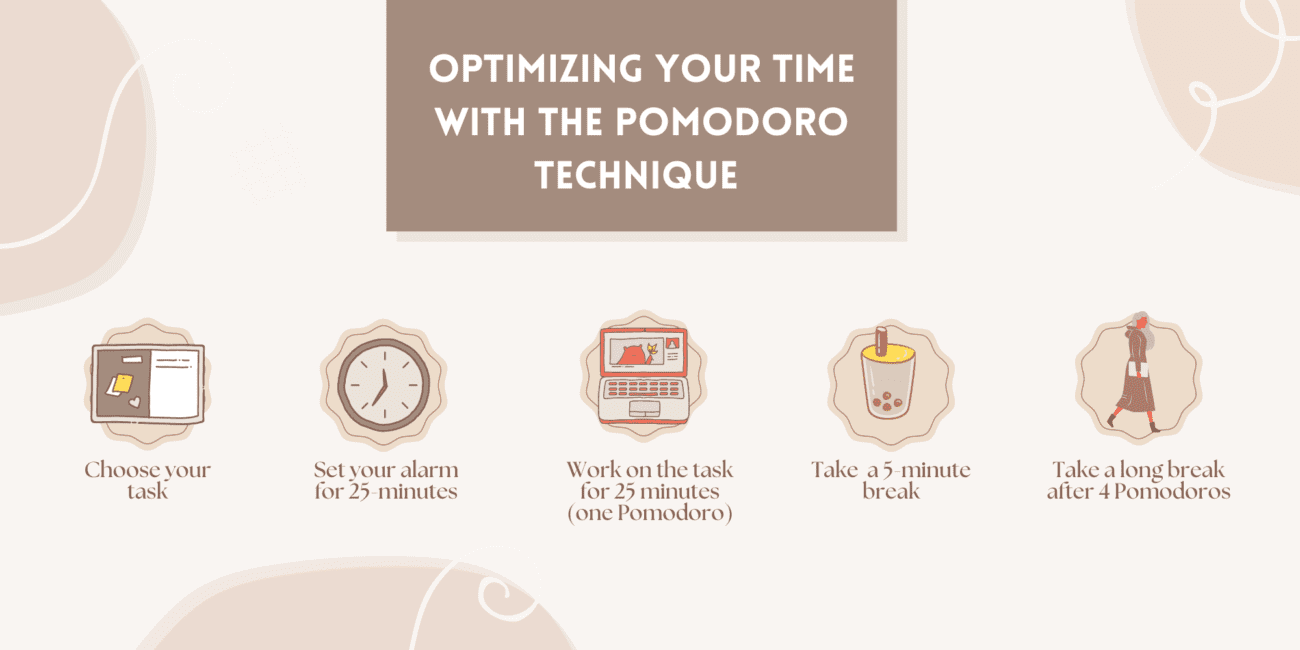
On August 14th, we’re hosting our inaugural Focus and Flex Challenge. This 7-day, easy-to-follow program is designed to empower women in creative fields through a combination of focused productivity, mindfulness, and self-care.
This challenge pairs the Pomodoro Technique with a daily stretch regimen tailored to the specific needs of women, including those who are differently abled.
Focus & Flex will not only enhance your productivity but also encourage you to develop a deeper connection to your inner self and your body.
These moments of self-care and rejuvenation are essential! If you're hoping to find fresh energy and motivation to conquer your everday challenges, sign up and join us.
What Science Says About Shorter Periods of Intense Work
Research in psychology and cognitive science provides insights into the effectiveness of shorter periods of intense focus or work, such as those promoted by the Pomodoro Technique. Overall, science supports the idea that shorter periods of intense focus or work, combined with regular breaks, can lead to improved productivity, focus, and overall well-being. However, individual preferences and work styles may vary, so it’s important that you find a routine that works best for you.
Increase Your Productivity
Studies suggest that breaking work into shorter intervals can enhance productivity. By focusing intensely on a task for a limited period, individuals are more likely to maintain a high level of concentration and motivation, leading to greater efficiency in completing tasks.
Get Focused
Short bursts of focused work can help individuals sustain attention and prevent cognitive fatigue. Research indicates that attention tends to wane over time, but brief breaks can help restore mental energy and maintain optimal performance.
Manage Your Time More Effectively
The Pomodoro Technique encourages individuals to prioritize tasks and allocate time effectively. By setting specific intervals for work and breaks, individuals can better manage their time and make efficient use of available resources.
Retain More Information
Interspersing focused work with short breaks can aid learning and memory consolidation. If you are taking a course or developing a new skill, the Pomodoro Technique could help you retain that information. Research suggests that spaced repetition and distributed practice are effective strategies for long-term retention of information.
Stop Procrastinating
Breaking tasks into manageable intervals can make them feel less overwhelming, reducing the likelihood of procrastination. The Pomodoro Technique's structured approach provides a clear framework for getting started and making progress on tasks.



What is the Pomodoro Technique?
Developed by Francesco Cirillo in the late 1980s, the Pomodoro Technique is a time management method that involves breaking work into intervals, typically 25 minutes in length, separated by short breaks.
First, select a task you want to accomplish. Then, set a timer for 25 minutes (known as one “Pomodoro” interval) and focus solely on the chosen task until the timer rings, avoiding any distractions or interruptions.
After the timer rings, take a short break of around 5 minutes to rest, stretch, or grab a snack. Repeat this process, starting another Pomodoro session after the short break. Once you’ve completed 4 Pomodoro sessions, take a longer, 30-minute break to eat, walk, or meditate. Make sure it’s physical!

The Pomodoro Technique is effective because it encourages focused work during the 25-minute intervals, with built-in breaks to prevent burnout and maintain productivity. According to Dr. Amrita Mandal, PhD in a resource for the Eunice Kennedy Shriver National Institute of Child Health and Human Development, “Regular breaks are important to do efficient work.” It also helps individuals break tasks into manageable chunks, making them feel less overwhelming. Many people find it helpful for improving concentration, managing distractions, and boosting productivity.
Why Did We Add a Stretching Component to the Focus and Flex Challenge?

Stretching throughout the day, even in shorter intervals, offers numerous benefits for both men and women. However, women may particularly benefit from regular stretching due to physiological differences and specific health considerations.
By incorporating short stretching breaks into their daily routine, women can reap the benefits of improved flexibility, reduced stress, enhanced posture, and better overall well-being.
Of course, it’s vitally important to listen to your body, so only choose stretches that feel comfortable and effective, and consult with a healthcare professional if you have any underlying health concerns or conditions.
Improve Your Flexibility and Mobility
Women, in particular, tend to have naturally greater flexibility than men, which makes stretching an essential component of maintaining joint health and preventing stiffness or discomfort, especially as they age.
Reduce Stress
Stretching releases tension in the muscles and promotes relaxation, helping to alleviate stress and anxiety. Women often juggle multiple roles and responsibilities, which can lead to increased stress levels. Incorporating short stretching breaks throughout the day can provide moments of relaxation and rejuvenation.
Prevent and Reduce Pain
Women are more prone to conditions such as lower back pain, neck tension, and pelvic floor dysfunction. Also, women may experience discomfort or cramping due to uterine contractions and hormonal changes. Stretching throughout the day can help prevent and alleviate these issues by reducing muscle tension, improving circulation, and promoting better posture.
Why Did We Include a Thought Prompt?
Each five minute break in our challenge includes a thought prompt that we hope you answer while stretching. Here’s why.
Firstly, it provides mental refreshment by allowing participants to take a break from focused work and recharge their minds.
Secondly, the prompts encourage reflection, helping individuals gain insights into their productivity habits, emotions, and overall experience during the work session. This fosters self-awareness and growth.
Additionally, engaging in thought prompts promotes mindfulness, as participants are encouraged to be present in the moment and cultivate a mindful approach to their work and self-care.
Moreover, prompts can spark creativity and inspiration, leading to new ideas and perspectives. This stimulates the brain and enhances problem-solving abilities, ultimately boosting productivity and innovation.
Finally, by addressing not only productivity but also emotional well-being, self-reflection, and personal growth, thought prompts support holistic well-being, contributing to a more balanced approach to work and life.



